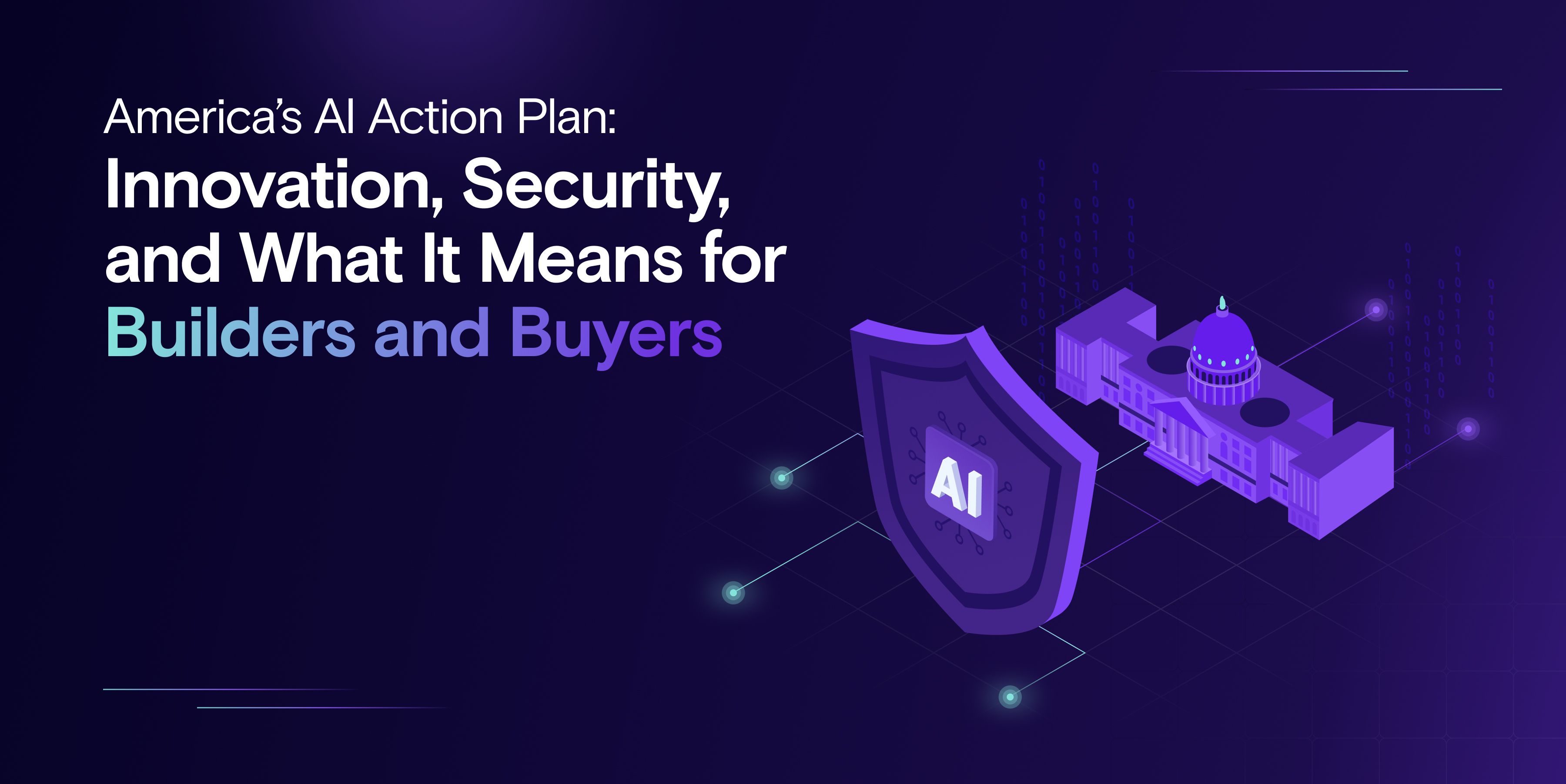America’s AI Action Plan: Innovation, Security, and What It Means for Builders and Buyers

On July 23, 2025, the White House unveiled America’s AI Action Plan during the Winning the AI Race Summit, marking a pivotal moment in the United States' approach to artificial intelligence. This plan follows Executive Order 14179, signed by President Donald Trump in January, which revoked prior regulatory constraints on AI and charted a new course focused on innovation, national leadership, and responsible growth. Together, the Executive Order and Action Plan articulate a vision for American AI that prizes openness, security, and global competitiveness.
The Action Plan is built around three core pillars of innovation, infrastructure, and international diplomacy and security. Each of these pillars were reinforced by new Executive Orders issued on the day of the plan’s release. These policy moves add operational momentum to the strategy and send a strong message: the U.S. government is all-in on fostering AI innovation, but not at the expense of resilience or national values.
At Zenity, we have long recognized that the rapid adoption of AI is an avenue for empowering individuals to create and innovate at new scales. Today’s blog delves deep into the policy’s key themes, its technical implications, and most importantly, outlines top priorities that technology builders and buyers should focus on to thrive under this evolving regulatory landscape.

The Three Pillars of America’s AI Future
Innovation
The first pillar affirms that AI should complement human capability, not replace it. The federal government is launching a revised National AI R&D Strategic Plan, led by the Office of Science and Technology Policy (OSTP), to steer research into high-priority areas like interpretability, model control, and robustness. Central to this pillar is a renewed commitment to openness, and in particular, the development and use of open-source and open-weight models.
Additionally, new AI Centers of Excellence and regulatory sandboxes will serve as collaborative spaces for testing models in real-world settings. These environments will be grounded in open data and shared results, promoting transparency, benchmarking, and reproducibility.
To jump start the goal of global adoption of American-built systems, the administration issued the Executive Order on Promoting the Export of the American AI Technology Stack. This directive establishes a national AI export program, encouraging U.S.-developed models and infrastructure to become the standard abroad.
Quick highlights:
- National R&D roadmap to prioritize explainability and safety
- Open-source and open-weight development prioritized for transparency
- New export program aims to globally scale U.S. AI systems
Infrastructure
The second pillar focuses on the physical and digital backbone of America’s AI future. The government is removing bottlenecks that delay the deployment of critical infrastructure, including supporting chip manufacturing and data centers built in the United States. NIST will take the lead in building sector-specific benchmarks to measure AI’s real-world impact, especially in key domains like healthcare, agriculture, and energy.
To fast-track this buildout, the White House issued the Executive Order on Accelerating Federal Permitting of Data Center Infrastructure, which streamlines approvals for high-priority AI-related facilities. This order reflects the urgency of creating the compute infrastructure needed to support scalable, secure AI systems.
Key actions include:
- Fast-tracking permitting processes for data centers
- Sector-specific AI benchmarks for measuring productivity
- Expanded support for public-private testing environments
International Diplomacy and Security
The third pillar recognizes AI as both a competitive asset and a national security issue. The plan outlines stronger protections against misuse, theft, and adversarial attacks, especially in defense and critical infrastructure. It also calls for continued cooperation with allies to set global norms for safe and ethical AI development.
This pillar is reinforced by the Executive Order on Preventing Woke AI in the Federal Government, which requires federal agencies to ensure that procured AI systems are free from ideological or political bias. In parallel, the plan encourages federal agencies to limit funding to states whose AI regulatory regimes may hinder national innovation, underscoring the desire for a cohesive, nationwide approach.
Supporting actions:
- AI procurement must meet objectivity and neutrality standards
- National coordination of security benchmarks and red teaming
- Federal funding influenced by state-level AI policies
Why Data Is the Unifying Thread
Threaded throughout all three pillars is a powerful theme: data is infrastructure, innovation fuel, and a security vector all at once. The plan emphasizes the need to improve the quality, accessibility, and security of data used in AI systems. Open datasets are key to innovation, while secure pipelines and documentation standards are vital for trust and resilience.
From regulatory sandboxes to productivity benchmarks, well-governed data will determine which AI systems succeed and which cannot be trusted. This includes:
- Publishing validated, shared datasets for scientific progress
- Using interoperable data schemas and open standards to reduce lock-in
- Protecting data pipelines from tampering, leakage, and misuse
What This Means for AI Vendors
If you build AI products, this plan offers both opportunity and accountability. First and foremost, secure-by-design is no longer optional. Buyers, especially in government, will expect threat modeling, access control, and adversarial testing from day one.
Open development practices are now strategically favored. Participating in open-source communities, publishing model weights, and contributing to federal testbeds will signal alignment with national priorities.
You should also prepare for greater scrutiny of your data pipelines, including how training data is sourced, documented, and protected. Federal partnerships and contracts will increasingly hinge on your ability to align with new NIST-led standards and risk management frameworks.
What This Means for AI Buyers and Users
For AI adopters, the policy shifts are equally important. Procurement will need to prioritize systems that are interpretable, secure, and portable. This means evaluating vendor claims about training data, testing for explainability, and demanding alignment with open standards and APIs.
Organizations should begin evaluating participation in regulatory sandboxes and public-private pilot programs. These environments offer a lower-risk way to test AI systems under federal guidance, using trusted data and sector-specific performance metrics.
Smart procurement going forward should include:
- Requirements for explainability, provenance, and auditability
- Vetting vendors for secure data practices
- Alignment with national and international AI safety benchmarks
Final Thoughts
The 2025 AI Action Plan and its supporting Executive Orders formalize a new national shift; AI innovation must be secured by design and governed with transparency. For security professionals, this isn’t just a regulatory signal, it’s a mandate to act. Whether you’re building AI systems or buying them, the message is clear, AI security is an organizational responsibility. Enterprises must move beyond reactive controls and embed risk management throughout the AI lifecycle from training data integrity to runtime monitoring and enforcement.
At Zenity, we believe security should accelerate, not inhibit, innovation. That means equipping security teams to enable safe, scalable AI adoption without bottlenecks or blind spots. It also means rejecting black-box approaches in favor of transparent and auditable systems that align with emerging standards from NIST, OWASP, etc.
AI innovation runs on data, but data is just one vector of risk. The true attack surface spans far beyond inputs and outputs. From prompt injection and jailbreaks, to identity misuses, over-permissioned agents, and unvetted plug-ins, security teams must govern not just what goes into AI systems, but how they behave and what they can access at runtime. To stay ahead, security leaders must:
- Build crossfunctional support within the organization. AI is a business led technology, so make sure security is a part of the journey from the beginning.
- Incorporate threat modeling and red teaming tailored to AI-specific abuse paths.
- Control blast radius by enforcing least privilege, session boundaries, and output filtering.
- Push for open standards that balance transparency, interoperability, and policy alignment.
Whether you’re building AI systems or buying them, now is the time to align with this vision. The U.S. isn’t just aiming to win the AI race. It’s creating the standards by which that race will be run, and ensuring that those standards prioritize safety, transparency, and strategic advantage.
All ArticlesRelated blog posts

The Genesis Mission: A New Era of AI-Accelerated Science and a New Security Imperative
Innovation has always been the engine of American advancement. With the launch of the Genesis Mission, the White...

Considerations for Microsoft Copilot Studio vs. Foundry in Financial Services
Financial services organizations are increasingly turning to AI agents to drive productivity, automate workflows,...

Claude Moves to the Darkside: What a Rogue Coding Agent Could Do Inside Your Org
On November 13, 2025, Anthropic disclosed the first known case of an AI agent orchestrating a broad-scale cyberattack...
Secure Your Agents
We’d love to chat with you about how your team can secure and govern AI Agents everywhere.
Get a Demo